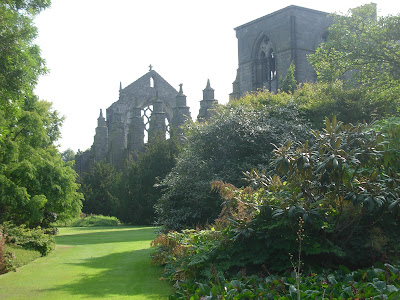For my first article on this blog, I must give honour where honour is due. Indeed, Holyroodhouse, located in Edinburgh, is known worldwide as the residence of Her Majesty the Queen Elisabeth II in Scotland.
As that is
the reason why is doesn’t hold the title of “castle”. A “castle” is a
stronghold, built in order to protect a territory from invasion. A “palace” is
usually a luxurious building, created only for the entertainment of its
owner.
Located
in a magnificent setting, at the foot of the Salisbury Crags and Arthur’s seat
(an extinct volcano), Holyrood
Palace had been built
next to an Augustinian abbey by James IV between 1501 and 1505.
But
the Palace as we know it was built in the 1670’s by Charles II, following its
earlier damage by fire. The Palace was transformed from a fortress into a large
residence thanks to Scottish architect Sir William Bruce.
Famous occupants
One
of the most famous residents of the Palace
of Holyroodhouse is Mary, Queen of Scots, who lived there from
her return to Scotland
in 1561 to her forced abdication in 1567. She married both of her Scottish
husbands in the palace: Henry Stewart, Lord Darnley and James Hepbrun. She also witnessed the
murder of her secretary David Rizzio, in her private apartments.
Just after the French Revolution, King George III allowed Louis XVI's younger brother and
future Charles X of France, the Comte d'Artois to live at Holyrood,
where he took advantage of the abbey sanctuary to avoid his creditors.
Her Majesty Queen Elizabeth II has a great deal of affection for Holyroodhouse, since her husband is
Duke of Edinburgh. Symbolically, the
palace is located in front of the Scottish Parliament…
It
is said that the ghost of the witch Agnes Sampson, who died in 1592, still
haunts the Palace.
The
Great Gallery
This
is the largest room of the Palace. It connects the King and the Queen apartments
together. Hung on the walls are a series of portraits. They represent the
monarchs of Scotland.
It has been used for the election of Scottish delegates to Westminster, and also as a Ball Room. Today,
it is regularly used by the Queen for receptions such as the investiture of
Scottish recipients of honour.
Holyrood
Abbey
At
the north-east corner of the Palace survive the ruins of Holyrood Abbey. Legends
associate its founding with a king’s vision of a cross between a stag’s
antlers. The abbey was destroyed after the raids of English armies in 1544. The
roof collapsed in 1768 and it has been left as a romantic ruin since then.
The
Gardens
Even though the Palace is located in a beautiful natural landscape, its
immediate surroundings are perfectly controlled. The 10 acres garden today provides
a magnificent setting for the Queen’s garden party, held annually in July
for 8000 people. Next to the gardens is the Queen's Gallery (opened in 2002) which displays works of art from the Royal Collection.





